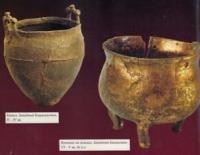You are here
Bestamak necropolis.

Tours on ancient monuments Kostanay of area.
“Bestamak is the most unique wealth of our region! It brought together so many eras, its materials are presented in a broad archaeological framework: from the Eneolithic to the Middle Ages”
Galina Satalkina.
Archaeological sights of Kostanay region.
Necropol Bestamak is located at an altitude of 114 meters above sea level, located 6.6 kilometers southeast of the village of Chile, in the northern part of the Turgai deflection, 2.9 kilometers northwest of the Ubagan River and 4.9 kilometers at 4.9 kilometers To the north-west of the origins of the Burktal River, which are the right tributaries of the Tobol River, 14.9 kilometers northeast of the village of Yulievka in the Aulicol district of the Kostanay region.
Kostanay land had hided this amazing monument from scientists for a long time. Only in 1991, Necropolis was accidently discovered by shepherd. However, such cases are not common in the history of archeology.
News about this amazing discovery reached to the head of the archaeological laboratory in Kostanay region - Victor Logvin. As being an enthusiast and a big fan of archeology, Logvin immediately went to Auliekol district and was amazed to find a unique historical material, which had an enormous scientific value.
The necropolis Bestamak had attracted the attention of scientists and archaeologists of Kazakhstan since 1991. The monument had been studied by archaeological expedition of Turgay for nine field seasons in 1991 - 1993, 1997, 2002, 2003, 2005 - 2008.
Necropolis Bestamak entered the state republican program "Cultural heritage". Funds for studying the object were divided from regional budget. A monument was deservedly included to the list of cultural heritage of Kostanay region.
Sayings of Deputy Director of the Regional Museum Research Galina Satalkina about this monument: "Bestamak is a unique treasure of our region! It is included to many ages, materials of which present an extensive archaeological framework: from the Chalcolithic to the Middle Ages".
Almost each archaeological season of Bestamak gave scientists new findings. Rare burial of Stone Age had been found six years ago, later archaeologists found the evidence of the Andronov culture.
One of the most striking patterns findings in Bestamak - hanging plaque with delicate and thin weaves.
In fact, this unique thing is a fine piece of work. Kazakh archaeologists showed it to Russian colleagues from Chelyabinsk, also to investigators of the Andronov culture, but those could not boast with similar findings from monuments of Andronov culture.
Today the total area is 9092 sq. The ground of burial was excavated and studied more than 170 burial pits and ritual structures during investigation period. The investigation of these objects showed that the Bestamak burial was used by ancient inhabitants of Torgai deflection for a great length of time from the Stone Age (Chalcolithic) to the Middle Ages.
The uniqueness of the burial Bestamak is the first and the only burial ground in northern Kazakhstan, the proceedings of which present archaeological framework: from the Chalcolithic to the Middle Ages.
It gives an opportunity to trace the features of the burial rite in the territory of one burial in different archaeological era, which were left by people, sequentially changed one after another. In general, investigations in Bestamak repository show that necropolis had acted since the Eneolithic until the Middle Ages.
Geographic coordinates of Necropolis Bestamak: N52 ° 10'05.33 "E64 ° 28'10.28"
Authority:
«Kazakh SSR» the Brief encyclopedia. The editor-in-chief. R.N.Nurgaliev, Alma-Ata, Main рекактор. The Kazakh Soviet encyclopedia, 1991. - volume 4, «Language. The literature. Folklore. Art. Architecture», With. 315. - 31 300 copy - ISBN 5-89800-023-2. The decision of Ministerial council Kazakh SSR from January, 26th, 1982 38 «About monuments of history and culture Kazakh SSR Republican value». Malgabar Mendikulov. «Monuments of national architecture of the Western Kazakhstan», Alma-Ata, 1987. http://culturemap.kz







